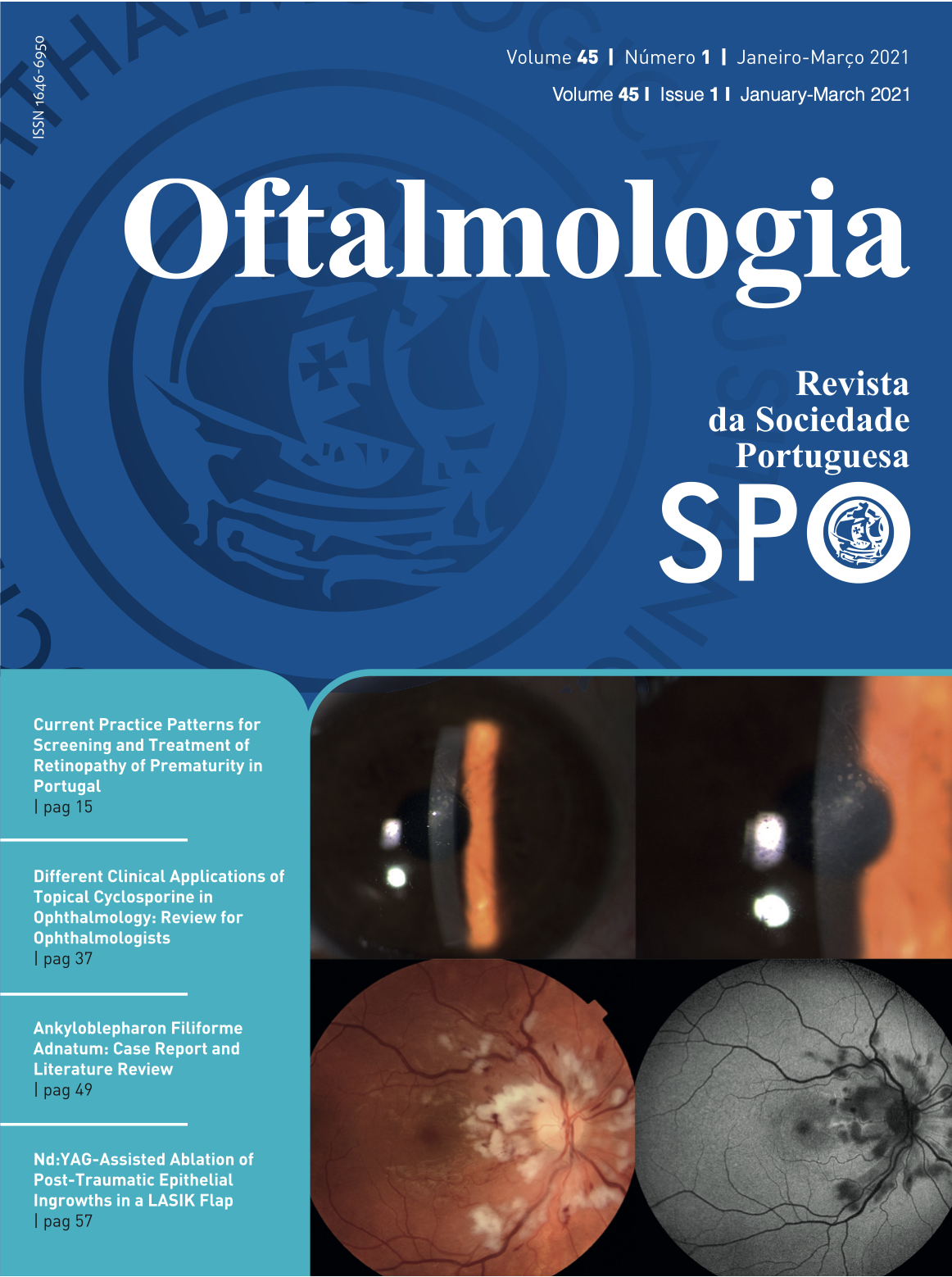Anquilobléfaro Filifome Congénito: Relato de Caso e Revisão da Literatura
DOI:
https://doi.org/10.48560/rspo.23910Palavras-chave:
Anomalias Congénitas do Olho/diagnóstico, Anomalias Congénitas do Olho/cirurgia, Pálpebras/cirurgia, Recém-NascidoResumo
O anquilobléfaro filiforme congénito (AFC) é uma condição rara caracterizada por uma fusão palpebral que pode ser parcial ou completa, com risco de ambliopia de privação. Um recém-nascido do sexo feminino com quatro dias de vida foi referenciado ao serviço de Oftalmologia por adesão palpebral bilateral. Para além da idade materna avançada, não existiam outros antecedentes obstétricos relevantes. Foi realizada uma excisão cirúrgica das adesões palpebrais ao nível da margem palpebral, sem intercorrências. O exame neonatal do recém-nascido era normal, sem alterações sistémicas ou outras anomalias oftalmológicas. O AFC pode estar associado a síndromes sistémicos e o tratamento deve ser realizado assim que o diagnóstico for estabelecido.
Downloads
Referências
Hasner V. Ankyloblepharon filiforme adnatum. Z Heilkol. 18881;2(429).
Koubek M, Strakošová K, Timkovič J, et al. A rare form of ankyloblepharon filiforme adnatum associated with the Hay–Wells syndrome and a c.1709T>C mutation on the TP63 gene: Hay–Wells syndrome–novel mutation on the TP63 gene. Ophthalmic Genet. 2018;39(2):251-254. doi:10.1080/13816810.2017.1401091
Sharkey D, Marlow N, Stokes J. Ankyloblepharon Filiforme Adnatum. J Pediatr. 2008;152(4):594. doi:10.1016/j.jpeds.2007.12.051
Evans DGR, Evans ID, Donnai D, Lindenbaum RH. Ankyloblepharon filiforme adnatum in trisomy 18 Edwards syndrome. J Med Genet. 1990;27(11):720-721. doi:10.1136/jmg.27.11.720
Mohamed YH, Gong H, Amemiya T. Role of apoptosis in eyelid development. Exp Eye Res. 2003;76(1):115-123. doi:10.1016/S0014-4835(02)00269-5
Gruener AM, Mehat MS. A newborn with ankyloblepharon filiforme adnatum: A case report. Cases J. 2009;2(8):1-2. doi:10.4076/1757-1626-2-8146
D I CLARK AND A PATTERSON. Ankyloblepharon filiforme adnatum in trisomy 18 (Edwards’s syndrome). Br J Ophthalmol. 1985;69:471-473.
Scott M, Richard J FB. Ankyloblepharon filiforme adnatum associated with infantile glaucoma and iridogoniodysgenesis. J Pediatr Ophthalmol Strabismus. 1994;31:93-95.
Williams MA, White ST, McGinnity G. Ankyloblepharon filiforme adnatum. Arch Dis Child. 2007;92(1):73-74. doi:10.1136/adc.2006.103069
STERN CHAALM. Ankyloblepharon filiforme adnatum. Brithish J Ophthalmol. 1979.
Chandana Chakraborti, Krittika Pal Chaudhury, Jayanta Das and AB. Ankyloblepharon Filiforme Adnatum: Report of Two Cases. Middle East Afr J Ophthalmol. 2014;21(2):200–202.
Malek I, Mekni M, Sayadi J, Bezzine A, Zghal I, Nacef L. Ankyloblepharon filiform adnatum: Beyond the eye. Tunisie Medicale. 2019;97(6):822-825.
Alami B, Maadane A, Sekhsoukh R. Ankyloblepharon filiforme adnatum: A case report. Pan Afr Med J. 2013;15(1):1-3. doi:10.11604/pamj.2013.15.15.2209
Kuruvilla, Elizabeth. Simha A. A rare variant of ankyloblepharon filiforme adnatum associated with skin hypopigmentation: A case report from South India. Indian J Ophthalmol. 2016;64(3):241–243.
Downloads
Publicado
Como Citar
Edição
Secção
Licença
Não se esqueça de fazer o download do ficheiro da Declaração de Responsabilidade Autoral e Autorização para Publicação e de Conflito de Interesses
O artigo apenas poderá ser submetido com esse dois documentos.
Para obter o ficheiro da Declaração de Responsabilidade Autoral, clique aqui
Para obter o ficheiro de Conflito de Interesses, clique aqui





